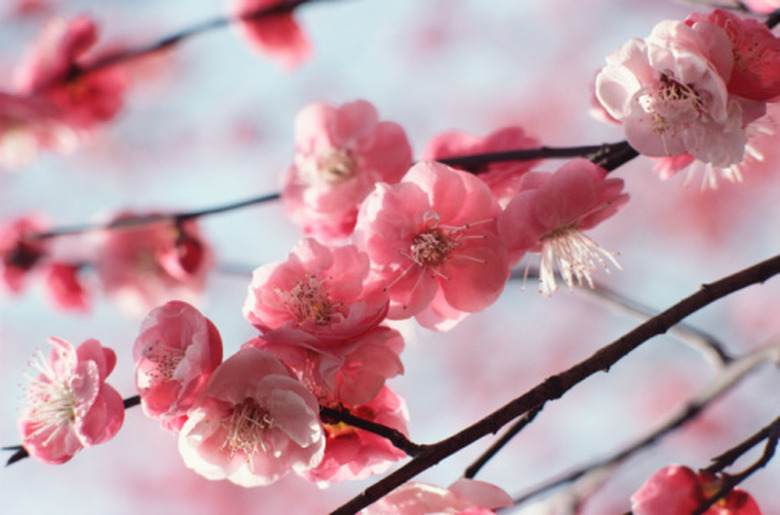Information On The Chinese Cherry Tree
Oriental cherry (Prunus serrulata) is native to China, Korea and Japan. This species of cherry is the ancestor of the Sato-zakura group of Japanese cherry trees. The Oriental cherry is often a focal point in gardens, where clusters of flowers can be admired up close.
Oriental cherry (Prunus serrulata) is native to China, Korea and Japan. This species of cherry is the ancestor of the Sato-zakura group of Japanese cherry trees. The Oriental cherry is often a focal point in gardens, where clusters of flowers can be admired up close.
Description
There are many cultivars of the Oriental cherry that offer single and double blooms in shades of pink and white. In general, this tree has a rounded form and reddish-brown bark. Foliage may turn bronze in fall. Flowers appear just before the emergence of leaves.
- Oriental cherry (Prunus serrulata) is native to China, Korea and Japan.
- The Oriental cherry is often a focal point in gardens, where clusters of flowers can be admired up close.
Growing Conditions
The Oriental cherry is susceptible to injury from pests and diseases, as well as environmental stresses, such as air pollution and compacted soil. For these reasons, it is regarded as a short-lived tree. The Oriental cherry does well in moist and well-drained soil and full sun. It is cold hardy to United States Department of Agriculture plant hardiness zone 5.
Popular Cultivar
The Kwanzan cherry is a popular cultivar of the Oriental cherry and was introduced to American gardens in 1903. Double pink flowers decorate the tree's vase-like canopy in April and May. Every spring in Washington D.C., the Cherry Blossom Festival celebrates the showy blooms of the Kwanzan and Yoshino cherry trees.
- The Oriental cherry is susceptible to injury from pests and diseases, as well as environmental stresses, such as air pollution and compacted soil.
- The Oriental cherry does well in moist and well-drained soil and full sun.
Cherry Tree
Cherry trees have white or pink flowers arranged in small clusters, and most species and cultivars have five-petaled flowers, like most other members of the Rosaceae family. Some double-blooming varieties have many additional petals giving a fuller look. The leaves are also finely serrated around the margin. Determine the characteristics of the bark. Most cherries have either grayish-brown or reddish-brown bark and are patterned with conspicuous horizontal marks called lenticels. Notice whether the flowers are present before or along with the leaves' appearance. Ornamental and orchard varieties display their flowers before the leaves emerge and start to fade as the tree leafs out. Black cherries and similar wild cherries, however, display their flowers while the leaves are present.
- Cherry trees have white or pink flowers arranged in small clusters, and most species and cultivars have five-petaled flowers, like most other members of the Rosaceae family.
- Black cherries and similar wild cherries, however, display their flowers while the leaves are present.
Cherry Tree
Cherry trees have white or pink flowers arranged in small clusters, and most species and cultivars have five-petaled flowers, like most other members of the Rosaceae family. Some double-blooming varieties have many additional petals giving a fuller look. The leaves are also finely serrated around the margin. Determine the characteristics of the bark. Most cherries have either grayish-brown or reddish-brown bark and are patterned with conspicuous horizontal marks called lenticels. Notice whether the flowers are present before or along with the leaves' appearance. Ornamental and orchard varieties display their flowers before the leaves emerge and start to fade as the tree leafs out. Black cherries and similar wild cherries, however, display their flowers while the leaves are present.
- Cherry trees have white or pink flowers arranged in small clusters, and most species and cultivars have five-petaled flowers, like most other members of the Rosaceae family.
- Black cherries and similar wild cherries, however, display their flowers while the leaves are present.
References
- Arbor Day Foundation: Cherry, Kwanzan
- "Botanica's Pocket Trees & Shrubs"; H. F. Ullmann; 2006
- North Carolina State University: Prunus Serrulata
- Ohio State University: Prunus Serrulata — Japanese Flowering Cherry or Oriental Cherry (Rosaceae)
- Iowa State University Forestry Extension: Black Cherry
- Missouri Botanical Garden: Prunus "Snofozam"
- Iowa State University Forestry Extension: Black Cherry
- Missouri Botanical Garden: Prunus "Snofozam"
